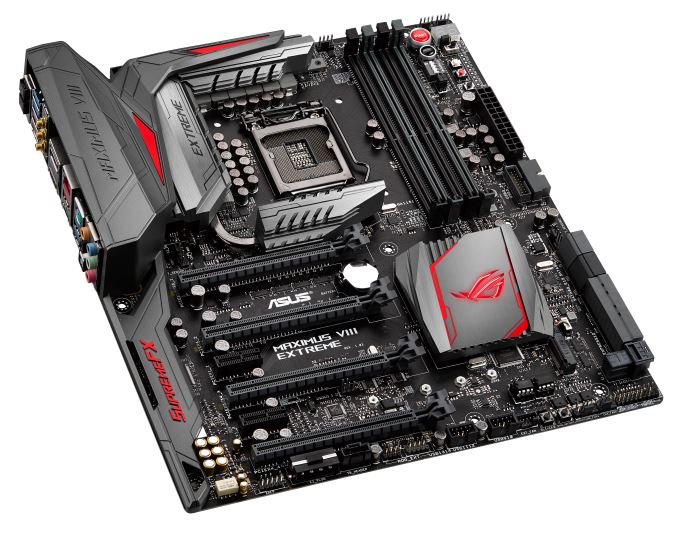The ASUS Maximus VIII Extreme Review: The Other $500 Option
by Ian Cutress on April 7, 2016 9:00 AM EST- Posted in
- Motherboards
- Gaming
- Asus
- ROG
- Skylake
- Z170
- Thunderbolt 3
ASUS Maximus VIII Extreme Conclusion
I mentioned at the top of the review that this is the second halo motherboard we’ve tested. Both the ASUS Maximus VIII Extreme and GIGABYTE Z170X-Gaming G1 command a large price but represent the premium product from the two major motherboard players in the industry. For the sale, each side focuses on specific areas:
| ASUS Maximus VIII Extreme vs GIGABYTE Z170X-Gaming G1 MSRP $500 |
||
| Motherboard | ASUS Maximus VIII Exteme | GIGABYTE G170X-Gaming G1 |
| Warranty Period | 3 Years | 3 Years |
| Product Page | Link | Link |
| Price | Amazon US | Amazon US |
| Size | E-ATX | E-ATX |
| CPU Interface | LGA1151 | LGA1151 |
| Chipset | Intel Z170 | Intel Z170 |
| Memory Slots (DDR4) | Four DDR4 Supporting 64GB Dual Channel Up to 3866 MHz |
Four DDR4 Supporting 64GB Dual Channel Up to 3666 MHz |
| Video Outputs | HDMI DisplayPort |
HDMI |
| Network Connectivity | Intel I219-V 3T3R 802.11ac |
2 x Killer E2400 Killer AC-1535 2T2R 802.11ac |
| Onboard Audio | Realtek ALC1150 with ESS ES9023P DAC bypass |
Creative Sound Core 3D + JRC NJM2114 + Burr Brown OPA2134 |
| PCIe Slots for Graphics (from CPU) |
3 x PCIe 3.0 - x16, - x8/x8, - x8/x4/x4 |
4 x PCIe 3.0 via PLX8747 - x16/x16, - x16/x8/x8, - x8/x8/x8/x8 |
| PCIe Slots for Other (from PCH) |
1 x PCIe 3.0 x4 2 x PCIe 3.0 x1 |
3 x PCIe 3.0 x1 |
| Onboard SATA | Six, RAID 0/1/5/10 Two from ASMedia ASM1061 |
Six, RAID 0/1/5/10 Four via ASM1061, no RAID |
| Onboard SATA Express | Two, RAID | Three |
| Onboard M.2 | 1 x PCIe 3.0 x4 or SATA, RAID 0/1, NVMe |
2x PCIe 3.0 x4 or SATA, RAID 0/1, NVMe |
| Onboard U.2 | 1 x PCIe 3.0 x4 (switched with M.2) | None |
| USB 3.1 | 2 x Type-A (ASM1142) 1 x Type-A (Alpine Ridge) 1 x Type-C (Alpine Ridge) |
1 x Type-A (Alpine Ridge) 1 x Type-C (Alpine Ridge) 1 x Type-A (Front Panel bundle) 1 x Type-C (Front Panel bundle) |
| USB 3.0 | 4 x Rear Panel 4 via headers |
4 x Rear Panel 2 via headers |
| USB 2.0 | - 6 via headers |
2 x Rear Panel 4 via headers |
| Power Connectors | 1 x 24-pin ATX 1 x 8-pin CPU 1 x 4-pin CPU |
1 x 24-pin ATX 1 x 8-pin CPU |
| Fan Headers | 2 x CPU (4-pin) 4 x CHA/SYS (4-pin) |
2 x CPU (4-pin) 5 x CHA/SYS (4-pin) |
| Notes | Bundled OC Panel | Bundled USB 3.1 Panel Combination air/water heatsink |
The big selling points for the Z170X-Gaming G1 are the PLX8747 chip enabling 32 PCIe lanes for 3-way and 4-way SLI, three Killer based network points for DoubleShot-X3 Pro, a combination air/water chipset heatsink, dual M.2, a USB 3.1 front panel, PCIe guards, and a Creative Sound Core 3D audio codec with a Burr Brown op-amp.
The big selling points for the Maximus VIII Extreme are the 3x3 Wi-Fi module, onboard U.2 support, a total of four onboard USB 3.1 ports, an ES9023P audio DAC, a bundled OC Panel, system performance and the BIOS/software package.
Both motherboards are validated with Thunderbolt 3.
It’s an interesting scenario being played out. ASUS wins on the performance side, the BIOS and software are easier to use, and overclocking wins out due to LLC implementation. 3x3 WiFi plus U.2 is hard to ignore on the Extreme as well. But the multi-GPU support of the GIGABYTE via the PLX is the massive plus that can’t be made up elsewhere (and non-GPUs can be used as well).
Both sides have impressive feature sets, and both sides have areas for improvement. If the price is still a factor and the prices of these motherboards decrease over time, if the GIGABYTE ends up $50-75 less expensive in a direct comparison, it would be hard to pass up that saving to spend elsewhere. Under the 100-series platform and Skylake processors, ASUS takes the crown up to dual GPU here, whereas by virtue of support the GIGABYTE motherboard happily takes it for 3-way and 4-way.
I’d happily recommend the ASUS to any performance junkie, but sometimes big performance needs big PCIe, and I’d happily recommend the GIGABYTE in that case.

Recommended by AnandTech
The ASUS Rampage VIII Extreme Motherboard
For Your Local Performance Junkie, Dual GPU and under
Other AnandTech Reviews for Intel’s 6th Generation CPUs and 100-Series Motherboards
Skylake-K Review: Core i7-6700K and Core i5-6600K - CPU Review
Comparison between the i7-6700K and i7-2600K in Bench - CPU Comparison
Overclocking Performance Mini-Test to 4.8 GHz - Overclocking
Skylake Architecture Analysis - Microarchitecture
Z170 Chipset Analysis and 55+ Motherboards - Motherboard Overview
Discrete Graphics: An Update for Z170 Motherboards - PCIe Firmware Update
Price Check: Intel Skylake i7-6700K and i5-6600K - Latest Skylake Price Check (3/29)
100-Series Motherboard Reviews:
Prices Correct at time of each review
($500) The GIGABYTE Z170X-Gaming G1 Review
($500) The ASUS Maximus VIII Extreme Review (this review)
($250) The ASUS Maximus VIII Impact Review
($240) The ASRock Z170 Extreme7+ Review
($230) The MSI Z170 Gaming M7 Review
($208) The GIGABYTE Z170-UD5 TH Review
($165) The ASUS Z170-A Review
($125) The Supermicro C7H170-M Review
Motherboard Reviews Planned:
For anyone not interested in the $500 motherboard segment, the next one up on the block is the MSI Z170A SLI PLUS, which comes in at $120-130. Stay tuned for that review. We've also got a couple of server focused Skylake boards waiting in the wings.











70 Comments
View All Comments
Flunk - Thursday, April 7, 2016 - link
At that price point you really should be considering an X99-platform system. You're scraping the bottom of the barrel when it comes to diminishing returns.xthetenth - Thursday, April 7, 2016 - link
This board does make sense for people who need a set of high end features that precludes any other boards, but that's few and far between.dsumanik - Friday, April 8, 2016 - link
Lot of talking up the gigabyte 4 way SLI, which was never even tested... As a reviewer wouldn't you wonder if it even works? Curious about the performance? Isn't that the whole reason for this website? To see how the latest and greatest tech performs? Anyways 500 bucks. Nah.jameskatt - Saturday, May 14, 2016 - link
That is the whole point. ASUS makes this motherboard for the few and far between.Ubercake - Thursday, April 7, 2016 - link
I was thinking that same thing. Why are motherboards going up so much in cost when the Processors have taken over most if not all of what used to be the Northbridge functions?If anything the motherboards should be worth less than they were before because for the most part, they aren't providing as much functionality. Granted, some have better voltage control and over-clocking capability, but that shouldn't add much to the cost comparatively. And this isn't the enthusiast lineup either. Not sure what these companies expect.
willis936 - Thursday, April 7, 2016 - link
You don't want to see the BOM of a $500 non server board.jasonelmore - Thursday, April 7, 2016 - link
your paying for the software on most of this high dollar hardware stuff. i know you are probably no interested in that stuff, but asus see's it differently. their magins will always be more than Asrock, so they have to differentiate somehow.Medical equipment is notoriously overpriced for what it is, but it uses custom software that nobody else makes, so they can get away with jacking up the price 2000% over the bill of materials.
close - Friday, April 8, 2016 - link
Medical business is a different animal. The standards and certifications they have to meet/pass means even the basic functions must be implemented in a different (more expensive) way. Things that are acceptable on a consumer product might be totally unacceptable on a medical one where a BSOD might actually involve a death ;).The NB functions were integrated into the CPU but then again motherboards didn't always have 2 NICs, WiFi, tricked up audio, bundled OC panels, etc. And don't forget about the 80/20 rule. You get 80% or results with 20% of the cost but then hang on to your sit because the cherry on top comes at a price. Optimizing the board layout and traces costs and if you want it you'll have to dish out the $500. It's always been the same, the closer you get to the top the quicker the costs pile up.
I for one would never buy ROG again. Half of the stuff it offers is just wasted on me and I considered most features to be overkill and wasteful. I realized that after I started using (or not using) them. But then again there's always a market for this so why not? :)
jameskatt - Saturday, May 14, 2016 - link
If you want the best quality product, then you will pay for it. That is true of any product. The best ones generally take more work to create. It is not simply the cost of the goods to create it. The labor costs can be very high. If you are satisfied with lower quality, then so be it. But there are some who simply want the best and are willing to pay for it. A $500 motherboard is nothing compared to the $25,000+ cost of a high end PC which may include a $2000 CPU, $1200 GPU, $1000 SSD, $8000 data storage system, $5000 professional monitor, etc.chlamchowder - Thursday, April 7, 2016 - link
The processors that work with Z170 have a newer architecture and better performance per-core, while X99 can support processors with more cores (and tons of memory), but generally less per-core performance.It depends on what you need. Gaming, for example, still has trouble scaling even to four cores and can benefit quite a bit from more per-core performance. That said, spending $500 on a motherboard (X99 or Z170) is something I'll never understand.